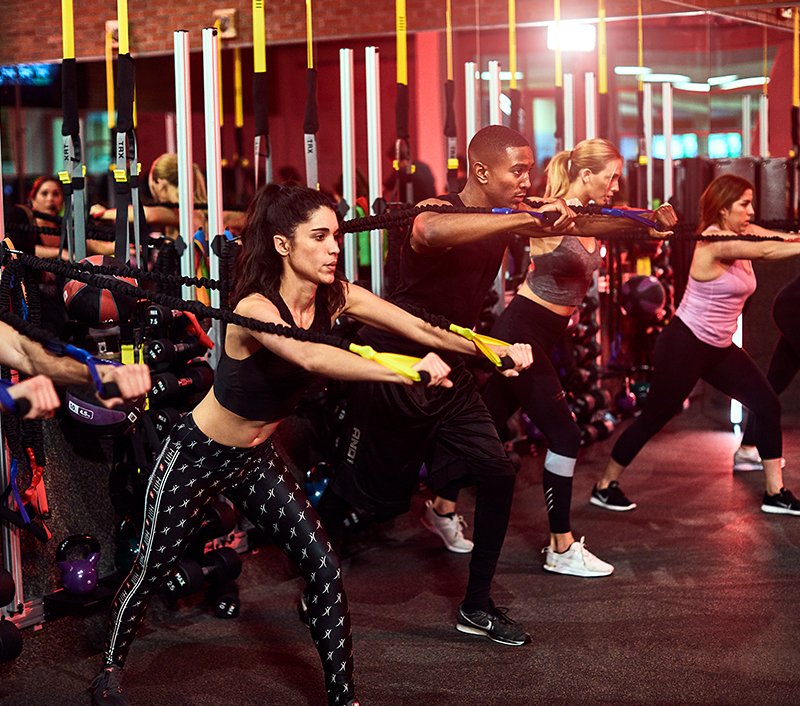High Energy Workouts for a Head Start on Swimsuit Season
It's easier to work hard when you’ve got a game plan. Here are some options to help keep you moving until the last second of your workout!

Knotted muscles are uncomfortable, to say the least, but they can also be debilitating if they’re bad enough. They can affect the surrounding muscles, be tender to touch, change how we’d normally do things, and can be painful to get rid of.
We’re going to give you some ideas on what you can do to find relief from this common problem.
A knot can feel like a tender, swollen, or tense spot in your muscles. Normally, when you run your fingers over a muscle, it should give slightly under the pressure. When you come across a knot, it may feel like there is a bump or hard spot that isn’t as supple as the surrounding muscle. If there is a lot of tension in the muscle, or if there are multiple knots that are close together, it can be harder to isolate each individual knot.






Knots can form pretty much anywhere in your body where there is muscle. Registered Nurse, Rachel Nall, identifies the following as the most common problem-areas:
Anything that strains your muscles in a manner that’s inconsistent with what they are used to can result in a knot.
They can come from stress, muscle overuse or underuse, injury, or bad posture. Unfortunately, there are a lot of things that can cause knots.
On the bright side, there are also a lot of things you can do to help with the pain. You can:
In addition to these, we’ve found some stretching techniques presented by Physical Therapists Bob Schrupp and Brad Heineck in their YouTube video: 60 Second Stretches to Get Knots from Shoulders, Upper Back, and Traps. Most of these stretches can be done from a seated position which makes them easy to do pretty much anywhere. One exercise is similar to a shoulder shrug. Schrupp explains that you should:
Another exercise they talk about looks like this:
The idea behind these exercises, Heineck explains, is to fatigue the muscles into relaxing. They will feel tight during the exercises but will tend to relax afterwards.
As with any type of exertion on your body, pay attention to what hurts to minimize your risk for injury. Start gradually and don’t over-do it, because it is possible to have too much of a good thing. To learn how you can handle and prevent back, knee, and shoulder injuries, listen to our Podcast, Episode 28. To help prevent future knotted muscles, read our post on The 10 Most Popular Exercises and How to Perform Them Properly. To access our monthly blog post highlights, subscribe to our newsletter today!


Over the course of a year, the average American spends about 293 hours behind the wheel and about 4,380 hours sitting down. That’s a lot of sedentary time! While it’s not always avoidable, leaving your car behind is one great way to get more active. Read on to learn how you can take opportunities today, and every day, to spend less time in the car and more time moving your body.

Some places, you simply can’t walk to. Not unless you’re planning on an extended backpacking trip. However, if you’re taking the kids to the park or making a run to the store for an item or two, going by foot may be perfect! Grab the sunscreen (rain or shine), put on some comfortable shoes, and bring a hat or umbrella if you think you might need it.
Remember that bike you bought a while back? The one gathering dust in storage or slowly becoming one with the grass in the yard? It’s time to find your helmet. Wherever is too far to travel on foot, is probably accessible by bicycling!


If you already spend a lot of time driving, when it’s time to do something fun for yourself or with the family, see if you can find some local events to attend. Maybe there’s a farmer’s market, a carnival, or a music festival nearby. If you know you’re going to drive anyway, choose something close to home so you can spend less time on the road and more time enjoying what you want!
You might live in a state with some serious weather, or because of some other factors, being without your car is nearly impossible. We have some tips for you too! If your health and ability permit, incorporating any amount of activity into your day will always be better than doing nothing at all. Take a look at some of these options for adding movement to your day:
Take the time you spend waiting – waiting in line at the coffee shop, waiting to use the copy machine, waiting for your lunch order – to do some simple exercises. Done right, calf raises can set your legs on fire (in a good way), and they are subtle enough to do while standing in one place.


Every so often, take a moment to stretch. Stretching will increase your blood circulation and give your muscles a break from whatever position you’ve been holding them in during the day. If your responsibilities require you to sit, hunch over, stand, or type all day, your body will thank you when you give it the opportunity to do something different.
Set an alarm on your watch, phone, or computer to remind you to move. You can go up and down the stairs a few times, walk around the block, or even around your desk a few times. If none of those are good options, do some exercises from your seat. You can try some seated crunches, arm or ankle rotations, or simply tighten and release your muscles to improve blood flow.

To learn more about how activity enhances your health, read our post on the Benefits of Living an Active Lifestyle, or get some nutrition tips by listening to our podcast on Fast Food and Your Body. To access our monthly blog post highlights, subscribe to our newsletter today!
Want new articles before they get published?
Subscribe to our Awesome Newsletter.

Getting motivated to hit the gym isn’t always as easy as it looks. Even if you manage to get through the doors, you might find yourself reasoning your way out of your least favorite exercises.
We’re here to talk about what you can do to pull yourself out of that funk and either start working out for the first time or reignite the motivation that’s slipping away.

01.
Adjust Your Goals and Make Them Achievable
Your goals can make or break you. If you set unattainable goals, you will find a lot of frustration along the way. Break down your larger goals into small steps. The completion of each step will be a victory in itself because it means you are progressing towards your major goal.
Suppose your major goal is to lose an inch off your waist before your cousin’s wedding in a few months. With the guidance of your doctor, trainer, or nutritionist, you will know to what extent you can task your body while still losing weight healthily.
For example, you might add 20 minutes of a new exercise to your weekly routine or adjust your diet by choosing water over soda. Making micro-changes is much more achievable than attempting to adopt multiple changes at once. For more helpful tips, listen to our Goals vs. Resolutions Podcast to hear from Personal Training Director, Tristen Alleman, who shares his thoughts on how members can successfully achieve their goals.
02.
Make It Easy to Get Started
Depending on the other responsibilities in your schedule, you may not have much control over the time of day you have available to work out. What you can control, is how easily you can get started when the time comes.
Make sure your workout clothes are clean and accessible. Have your duffel bag equipped with everything you might need to work out already inside. Make it as easy as possible to start your routine and you’ll find that, with fewer obstacles between you and the gym, you may actually make it through those doors.


03.
Change How Often You Track Your Progress
Tracking your progress can mean logging changes in your weight, taking your measurements, evaluating changes in your overall cardiac health, assessing changes in your strength or flexibility, and more. Taking note of these different stats can sometimes be a huge motivation killer if we are looking for consistent improvement but getting fluctuating numbers instead.
The key to staying motivated as you track your progress is to space out how often you measure change. For example, try measuring your weight weekly or even monthly instead of daily. Because of the way weight naturally fluctuates from day to day, you’ll get a more accurate (and less anxiety inducing) picture of your overall progress.
04.
Stay Future Focused
Keep your eyes on the prize! If you can focus on how amazing you know you’re going to feel once you’ve accomplished what you started, you can help push away the feelings of doubt that eat away at your motivation.
We know how hard it can be to keep focused on the future. It’s unpredictable, it’s always changing, and it’s nearly impossible to know how each choice we make will impact tomorrow. There may even be a complete shift in what your goals are.
The main idea here is to be open to all the uncertainties. You might hit a plateau and need to switch up your routine or find that an exercise is too hard on your body and need to scale things back. The more comfortable you are with change, the easier it will be to focus on your goal rather than on the setbacks or difficulties you encounter along the way.


05.
Remember That the Gym Is a Supportive Community
Having the support of others is a huge game-changer, and here at LA Fitness we crave your success! You can join our Online Community and connect with other members who are also working towards their fitness goals, and even track your workout schedule. We are so excited for your success that we want you to tell your story to motivate others and share your achievement. You can read about members who have changed their lives on our Member Spotlight feature.
For more motivation boosts, read our blog on Muscle Building and Fat Burning Myths or our Meal Prepping Guide for tips and tricks to get you through your meal preps. To access our monthly blog post highlights, subscribe to our newsletter today!

When a championship or trophy is on the line, every opportunity for an athlete to practice makes a difference. The same is true of exercise sessions in preparation toward achieving a physical goal. Too many people run through their workout just to check it off as done instead of utilizing the workout to its full potential. Instead, treat the session like elite athletes do – as a rehearsal for the biggest physical performance they’ll do that season.
“Make each day your masterpiece“ – John Wooden
Effort, drive and determination are often attributes associated with athletes pushing through tough practices. Hence, the “no pain, no gain” exercise motto. But enthusiasm, purpose and intense focus may be just as important for progress1. For successful workouts, having a positive attitude, a goal for that session and focused attention are key.

Three Key Factors You Need


01.
Enthusiasm is a cornerstone of the late basketball coach John Wooden’s famous Pyramid of Success2. He described enthusiasm as that “which infuses hard work with inspired power.” Without the passion and joy for what you are doing, you can easily slip into worker bee mode to get your workout over with. Enthusiasm is a spark that ignites the willingness to proceed. It’s characterized by feelings of excitement and high levels of enjoyment3. If you’re not loving what you are doing, find another way of doing it or switch up your workouts.

02.
Purpose Personal meaning powers action – it’s caring enough about what you’re doing. Finding your purpose goes beyond the outcome you seek, but the “why” you are striving for it to begin with. Putting your personal values as top priority can lead you to perform better4. Nothing else can take precedent during your exercise session. Purpose is supported by the belief that you are responsible for your own success. Having an identified purpose helps you overcome pressure and stress and to bounce back from losses.
“The successful warrior is the average man, with laser-like focus.“ – Bruce Lee

03.
Intense Focus With digital distractions it’s easy for one’s mind to wander off course. Sport psychologists say that being in the moment is crucial for effective practice5. Worry about what you can execute in the present instead of dwelling on the past. Pay greater attention to the action you’re doing instead of smartphone alerts, the environment around you or thoughts of the outcome. Whereas you might get away with reading while doing some low-intensity steady-state cardio, strength-training requires focus6.
Definition: Practice is the repetition of an action with the goal of improvement.
All that is not to say that the treadmill setting or weights have to be different or more than your last workout. On the contrary, repetition with good form allows you to improve on quantity or speed later. The TED-Ed video entitled “How to practice effectively…for just about anything” by Annie Bosler and Don Greene has an expanded explanation for the reasons why repeated practice works — one of them is neural processing. You actually create the neural pathway to do an action unconsciously by repeating it until the action becomes reflexive.
Treating your workout like a household chore to get done will likely make the session, well, …a chore. Consider each exercise session a rehearsal – a chance to fix mistakes and move forward toward a winning performance, even if you are the only audience. Embrace what you’re doing, make your purpose a priority and narrow your attention to your present action.
References


Most of us have been told a lie in the gym at some point. The real question is, did you believe it? If someone has helped you or given you tips, did you ever research what they said or did to see if it was true? There’s a chance that it was completely wrong.
We’re going to go over and debunk a handful of myths surrounding the ideas of muscle building and fat burning.
When we exercise moderately, it’s true that more fat can burn compared to carbohydrates. However, this type of training burns fewer total calories and takes significantly longer. High intensity exercises like HIIT (high intensity interval training) can burn more calories in a shorter amount of time and can cause an “after-burn” effect fueled by fat that can last a day or longer. I personally found success with HIIT training. HIIT by LAF is great for those interested in high intensity workouts looking to burn some calories!

“Don’t eat late at night.” “Eat dinner earlier.” “No carbs before bed.” These seem to be some common statements we hear for losing weight and they couldn’t be more inaccurate. Calories are calories and if you eat too many of them you’ll gain weight, regardless of what time it is. According to a , overweight people lost more weight eating carbohydrates at night compared to throughout the day. The late-night eaters had better hormone levels that control satiety and hunger. The Human Growth Hormone (HGH) is a powerful hormone produced by the human body that regulates the amount of body fat you burn and the amount of muscle you build. HGH levels peak while you’re sleeping so if you eat right before bed, your body could utilize those nutrients to build muscle and burn fat at the same time.

What’s going to burn more fat calories in 20 minutes: watching TV, walking, or interval sprinting? If you think it’s TV or walking, you’re wrong. Just because you burn a higher percentage of fat from moderate exercise doesn’t mean you’ll burn as many total fat calories. Interval sprinting burn a less percentage of fat but a much higher total calorie loss, which actually results in more fat calories burned than walking for 20 minutes.
A family member of mine went on a diet a while ago to try and lose weight. She was told to double her protein intake and eat less carbohydrates. She ended up miserable and weighing more than she did before her diet. We’re not saying protein doesn’t build muscle, but there’s a point where protein can hurt compared to help. For every pound of body weight, consuming about Any protein consumption over the 1.25g per pound of bodyweight can get broken down in to amino acids and nitrogen which can either store in your body or excrete your body.
If someone is trying to give you a fitness tip, listen to what they have to say but do your own research and come up with your own opinion. Everybody has a different body and genetic makeup. What works for one person might not work for another. Know what works best for you and own your workouts!
References
It's easier to work hard when you’ve got a game plan. Here are some options to help keep you moving until the last second of your workout!
Does liberally salting your food help you pump more iron in the gym? Registered Dietitian, Debbie James, investigates the claims!
It’s Multiple Sclerosis Awareness Month! Here is what you need to know about exercise safety with MS.
Be the first to know about exclusive
content, deals and promotions